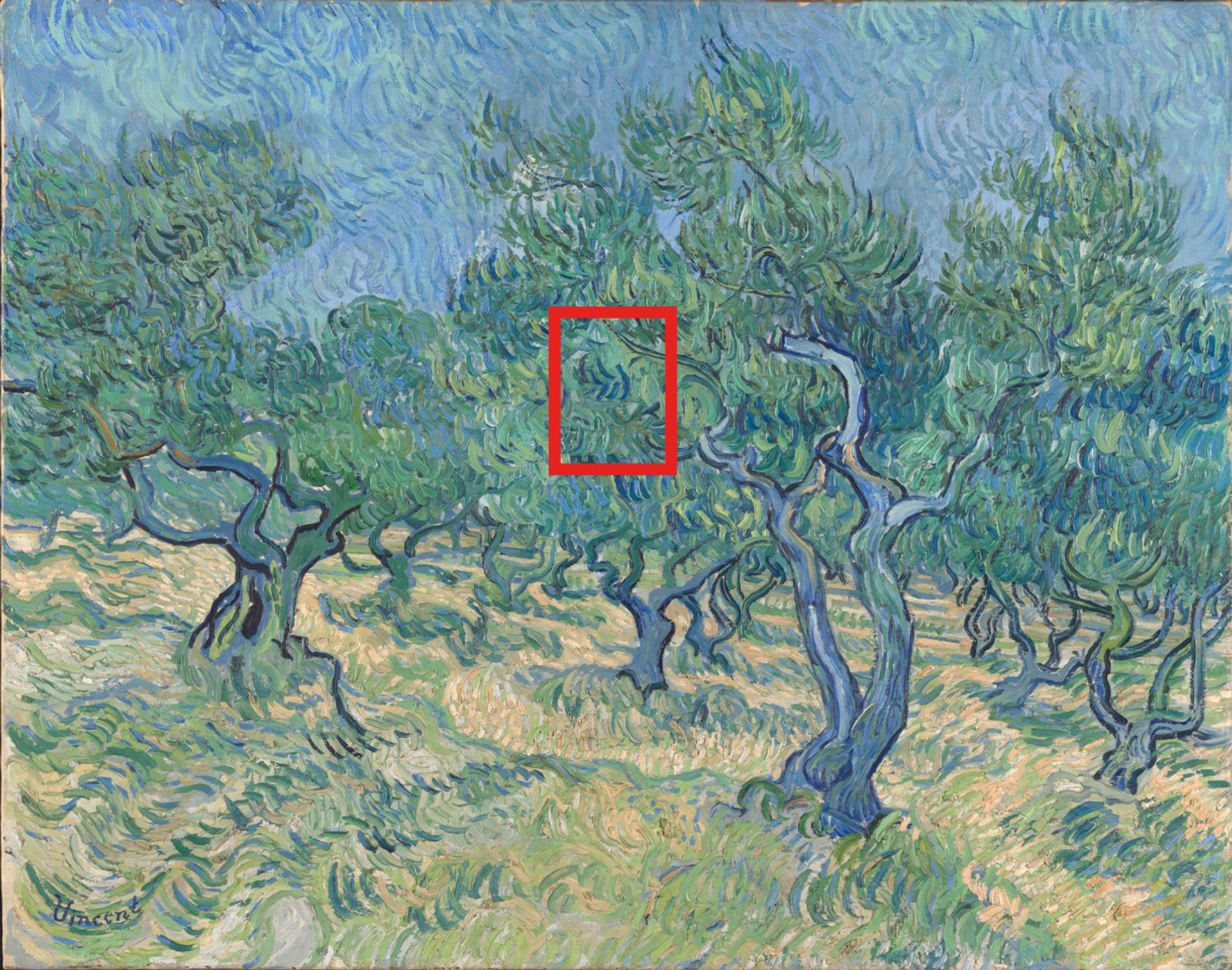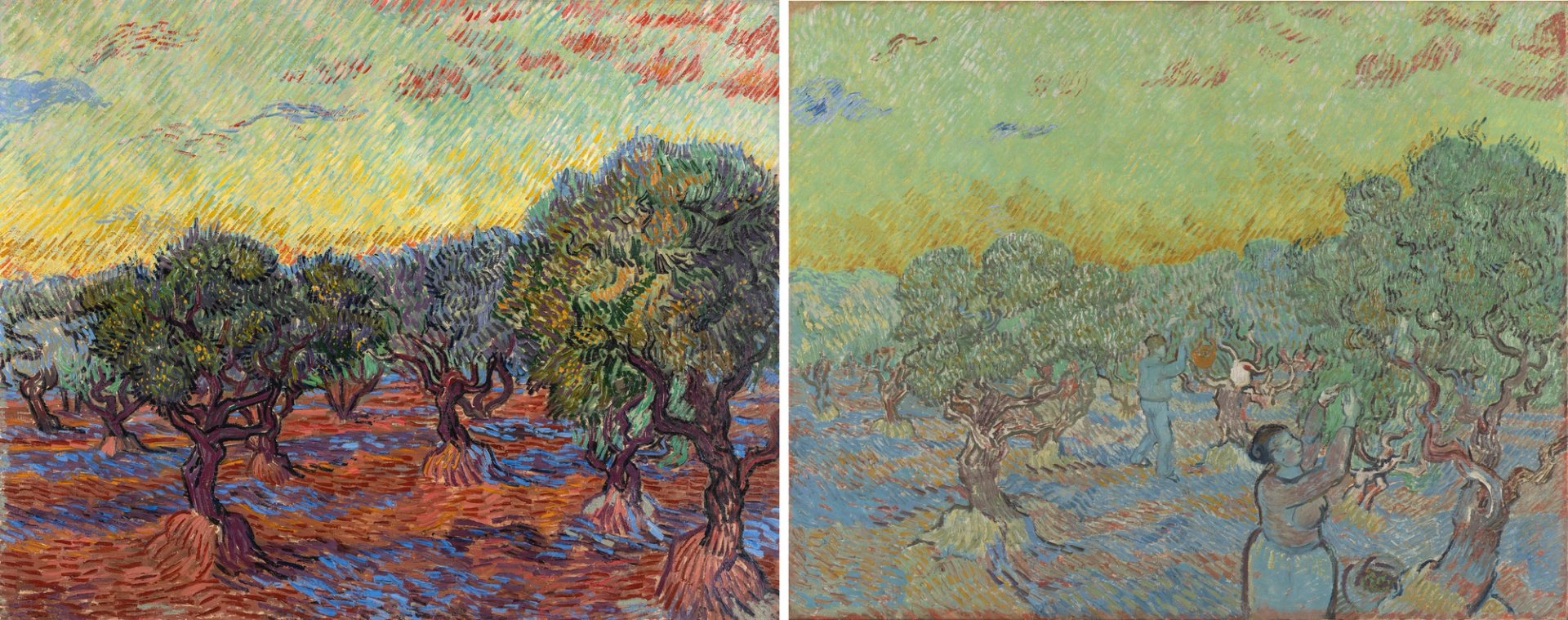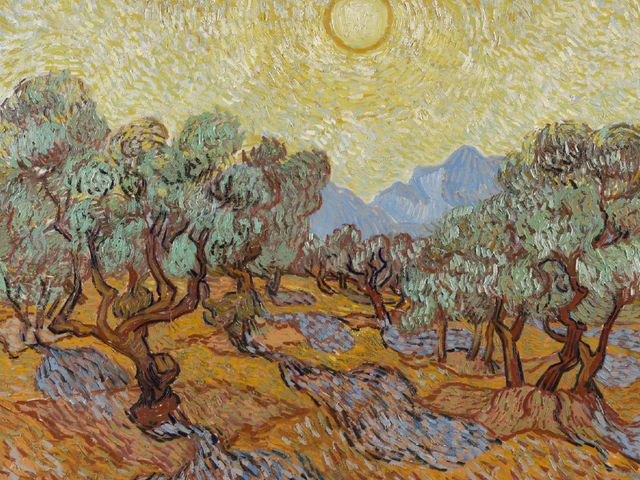The Dallas Museum of Art this week opened an exhibition on Van Gogh’s olive grove paintings. This series of 15 paintings was subjected to an intensive three-year research project by an international group of curators and conservators. Among the discoveries was finding a trail left by a small insect which crawled through the artist’s wet paint.

Van Gogh’s Olive Grove (July 1889), with the area where the insect landed indicated in red Courtesy of the Kröller-Müller Museum, Otterlo. Photo: Rio Klein Gotink
The insect, of an unidentified species, flew into Van Gogh’s impasto of Olive Grove (Kröller-Müller Museum, Otterlo), in the foliage in the centre of the composition. It desperately tried to escape, weaving its way through the artist’s blue and green brushstrokes.
Astonishingly, the trail—which had not been noticed until the painting was thoroughly examined under a microscope—is 18cm long, equivalent to a quarter of the height of the painting. No trace of the unfortunate insect was found, so it is unclear whether it finally escaped or was buried in later overpaint when Van Gogh completed the composition.
Theoretically the insect could have been been trapped in the olive grove or the artist’s studio, but further evidence almost certainly means that the first phase of the painting was done outside. A fragment of a blade of grass (or plant stem), a probable seed and sand particles were also found embedded in Olive Grove. In another painting of the series, Olive Trees (Nelson-Atkins Museum of Art, Kansas City), the remains of a grasshopper were earlier discovered in the paint.

Van Gogh’s Olive Trees (June 1889), Olive Trees (June 1889) and Olive Grove (November 1889) Courtesy of the National Galleries of Scotland, Edinburgh; Nelson-Atkins Museum of Art, Kansas City, Missouri (photo: Gabe Hopkins); and Van Gogh Museum, Amsterdam (Vincent van Gogh Foundation)
Van Gogh completed a series of olive grove paintings between June and December 1889, while he was living in the asylum just outside Saint-Rémy-de-Provence. Olives were then an important crop in the foothills of Les Alpilles. This is shown in a delightful 1930s illustration of the fruit being harvested, close to the Roman mausoleum tower near the entrance to the asylum.

Thornton Oakley’s Olive-gatherers of Saint-Rémy in Amy Oakley’s book, The Heart of Provence (1936)
Twelve paintings from the series have been brought together for the Dallas-Amsterdam exhibition Van Gogh and the Olive Groves, with three from US museums being unfortunately unavailable for loan because of their donor’s restrictions. All 15, however, have been subjected to a rigorous scientific analysis.
The biggest surprise is quite how much Van Gogh’s original colours have changed over the years. This is dramatically illustrated by two paintings that were originally done with a similar palette: pictures at the Gothenburg Museum of Art and Otterlo’s Kröller-Müller Museum. The landscape compositions are much the same, although the Otterlo picture, done a fortnight later, includes two olive pickers.

Van Gogh’s Olive Grove, Saint-Rémy (November 1889) (Gothenburg) and Olive Grove with two Olive Pickers (December 1889) (Otterlo). Courtesy of the Gothenburg Museum of Art (photo: Hossein Sehatlou) and Kröller-Müller Museum, Otterlo (photo: Rio Klein Gotink)
The Gothenburg painting has a relatively well-preserved appearance, retaining the original colour harmonies. But in the Otterlo work red pigments manufactured from cochineal insects have proved to be very light-sensitive and have deteriorated disastrously. Most of the reds, pinks and purples in the picture have almost entirely disappeared, transforming the appearance of the painting.
Research for the exhibition has also shown that the Otterlo painting, Olive Grove with Two Olive Pickers, was extensively retouched by the French artist Émile Schuffenecker in around 1910, when his brother Amédée owned the picture. The Dallas catalogue reveals that “Schuffenecker ‘finished’ the composition by applying red, orange and brown paint mixtures in broad, often sloppy strokes on areas of ground that Van Gogh had left visible”, mainly in the lower half of the composition.
It would be technically difficult to remove these additions. But another reason for leaving them is that Van Gogh’s original paint underneath would not have faded. Exposing these areas would produce a spotty effect next to the faded paint.
The scientific examination of the olive series has also helped to determine the order in which they were painted. For instance, the painting now in Edinburgh (National Galleries of Scotland) was until recently believed to be the one described in Vincent’s letter of 16 June 1889 about olive trees with violet shadows. But taking newly observed colour changes into account, the “violet” one is now thought to be the painting in Kansas City. The Edinburgh picture is therefore likely to be the first of the series.
Van Gogh and the Olive Groves runs at the Dallas Museum of Art until 6 February 2022. It will then transfer to the Van Gogh Museum in Amsterdam (11 March-12 June 2022). Although four of the olive grove paintings are only being lent to one of the two venues, in each presentation they will be supplemented with up to a dozen other related Van Gogh pictures.
Despite the current plethora of Van Gogh “immersive experiences” around the world, with huge photographic enlargements of the paintings, nothing beats the experience of seeing the real thing.
Other Van Gogh news
• A print of Van Gogh’s etching of Portrait of Dr Gachet (June 1890) is to be offered by Swann Auction Galleries in New York on 2 November. The estimate is $80,000-$120,000.






